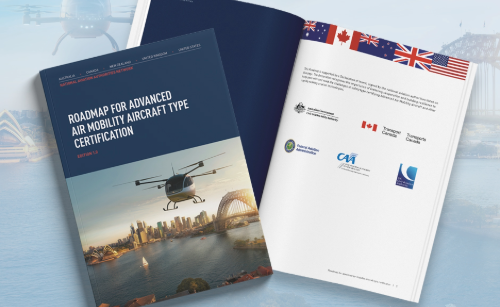Advanced Air Mobility (AAM) aircraft are set to be certified in a unified and streamlined way in the future following a landmark Roadmap established between national aviation authorities from Australia, Canada, New Zealand, the United Kingdom, and the United States.

The Roadmap for Advanced Air Mobility Aircraft Type Certification was released in Australia today.
It aims to ensure safety, foster collaboration, promote technological innovation, and streamline the certification and validation process for new aircraft types across international boundaries.
It was developed collaboratively by representatives from the Australian Civil Aviation Safety Authority (CASA), Transport Canada (TC), the New Zealand Civil Aviation Authority (NZ CAA), the United Kingdom’s Civil Aviation Authority (UK CAA) and the United States Federal Aviation Administration (FAA).
Aircraft type certification is a process that ensures a particular type of aircraft meets all the necessary safety and airworthiness standards set by aviation regulatory authorities.
Currently, traditional aircraft are type certified in the country of design using internationally harmonised airworthiness certification standards. Countries then validate the aircraft against these standards before the aircraft can be operated in other countries.
However, with new AAM aircraft types, there are differences in certification standards emerging across the world. The roadmap acknowledges these differences and provides a framework to converge and harmonise these standards.
Pip Spence, CASA Chief Executive Officer and Director of Aviation Safety, said there are significant benefits to collaborating across borders on advanced aircraft certification standards.
‘For operators, the Roadmap aims to reduce the certification burden once the AAM aircraft has received a type certificate and allow them faster entry to multiple countries through harmonised airworthiness standards and focused validation activities,’ Pip said.
‘By working together, we can ensure that the introduction of AAM aircraft is both safe and efficient, paving the way for the future of urban mobility.
‘Australia is excited to have been involved in this initiative, which is not only a world-first but will also help make urban and advanced air mobility a reality.’
About the working group
The Roadmap was created through a working group established by the national aviation authorities (NAAs) in Australia, Canada, New Zealand, the United Kingdom and the United States. The network was established to foster co-operation, learning and sharing of best practices by working in partnership on common and emerging challenges in aviation and aerospace and is dedicated to advancing aviation safety and innovation through international cooperation and alignment of regulatory standards.
Media contact
-
Aircraft
-
Aircraft registration
- Change, transfer or cancel aircraft registration
- Data files for registered aircraft
- Ferry flight registrations
- Find a registered aircraft
- Guidance for deceased estates
- Irrevocable deregistration and export request authorisation (IDERA)
- Register your aircraft
- Registered aircraft operators
- Registration marks
- Request a copy of your registration certificate
- Airworthiness
- Certification
- Design and manufacturing
- Sport aviation
-
Aircraft registration
- Drones
-
Licences and certificates
- Pilots
- Radio operators
- Air traffic controllers
-
Air operators
- Aerial application air operator's certificate
- Aerial work certificate (Part 138)
- Air transport air operator's certificate
- Alternative pathways for specialised endorsements
- Balloon air operator's certificate
- Flight training operators
- Foreign operators
- Guidance for Part 91 approvals
- Replace air operator's certificate
- Aerial photography from aircraft
- Delegates
-
Maintenance engineers
- About aircraft maintenance engineers
- Aircraft maintenance engineer exams
- Aircraft maintenance engineer licence (Part 66)
- Apply for a Part 66 licence
- Become a licensed aircraft maintenance engineer
- Maintenance of composite structures
- Part 66 and working for a Part 145 organisation
- Part 66 self-study training and examination pathway
- Recognition of prior learning
- Removing exclusions
- Licence currency and requalification
- Modular licensing for aircraft maintenance engineers
- Part 66 modular aircraft maintenance engineer licence pathways
- Flight examiners
- Flight instructors
- Aviation medicals
- Medical professionals
- Aviation reference numbers
- English language standards
-
Operations, safety & travel
- Aerodromes
- Airspace
- Aviation safety for pilots
- Safety Management Systems
-
Safety advice
- Cabin safety
- Carriage or discharge of firearms on aircraft
- Community service flights
- Cost sharing flights
- Dangerous goods and air freight
- Displays and events
- Drug and alcohol management
- Electronic flight bag
- Fatigue management
- Hazard identification and management
- Human factors and safety behaviours
- Mercy fights and operating in an emergency
- 5G and aviation safety
- Consumer and passenger advice
- Aeronautical information management
- Rotorcraft performance standards for flight operators
- Training and checking systems
-
Rules
- Regulatory framework
- Rules by category
- Rules by status
- Rules by type
- Changing the rules
-
Compliance and enforcement
- Delegated authority in support of aviation safety investigations
- Enforcement action
- How to comply with the rules
- Recent enforcement actions
- Safety information policy statement
- Sharing safety information
- Strict liability
- Surveillance
- Voluntary suspensions
- Recent enforcement actions
- Reporting unsafe behaviour
- Resources & education
-
About us
- Who we are
- Who we work with
- News, media releases and speeches
-
Reporting and accountability
- Environmental management and performance
- Freedom of information
- Gift and benefits register
- Gender pay gap employer statement
- List of CASA files
- Portfolio budget statements
- Register of privacy impact assessments
- Regulator Performance Framework
- Senate order on agency contracts
- Service standards
- Statement of commitment to child safety
- Work health and safety policy statement
- Protecting the environment
- External security vulnerability disclosure program
- Careers
- Sponsorship and scholarship
- About this website
- Contact us
- Events
- Subscribe

